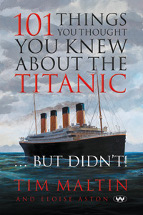101 things you thought you knew about the Titanic . . . but didn't by Tim Maltin

Wakefield Press, 2010. ISBN 978 186254 9234.
The 14th April 2012 marks the 100th anniversary of the night when
Titanic struck an iceberg off Newfoundland and sank with the loss of
over 1500 people.
The vessel and the disaster which befell her still captivate our
imagination after so many years and this marvellous book helps us to
understand the myriad factors which converged to culminate in this
catastrophic event.
Providing 101 entries ranging from great importance to minor
interest, the book seeks to inform, explain and clarify historical
details which have been clouded by time or misinterpreted after
repetition and hearsay. Relying upon a range of historical
documents, the most important being the U.S. and British
investigations into the sinking, the author has sought to address a
variety of commonly known facts, a few distorted myths and some
complete falsehoods which are associated with this terrible
disaster.
The appeal of this book is not restricted to those who are obsessed
with the topic who probably don't need to read it anyway. The
details provided are historically interesting to anyone remotely
aware of the disaster and it is written in such a way that it may be
consulted as a reference or read from cover to cover, depending upon
the reader's level of commitment.
I found the testimonies to be interesting, the engineering details
illuminating and the logical examination of science and evidence to
be compelling. Sadly, for some reason, no maps, diagrams or plans
have been included and this detracts markedly from the book's
intention of educating the reader concerning the details of the
incident. Some aspects, particularly the vessel's layout and
navigational manoeuvres on the night are simply impossible to
visualise from the text.
Examination and sensible analysis of source material by the author
makes this an engaging book which is extremely balanced and reserved
in its treatment of those who have been depicted in history as
incompetent, cowardly or villainous. Perhaps the most famous fact,
that too few life boats existed to carry the ship's complement - is
presented so calmly with reference to engineering principles, crew
numbers and remarkable safety statistics for trans-Atlantic
crossings that the reader is left satisfied that this was in fact
completely reasonable.
I encourage others to read this book to be similarly surprised by
other details.
Rob Welsh